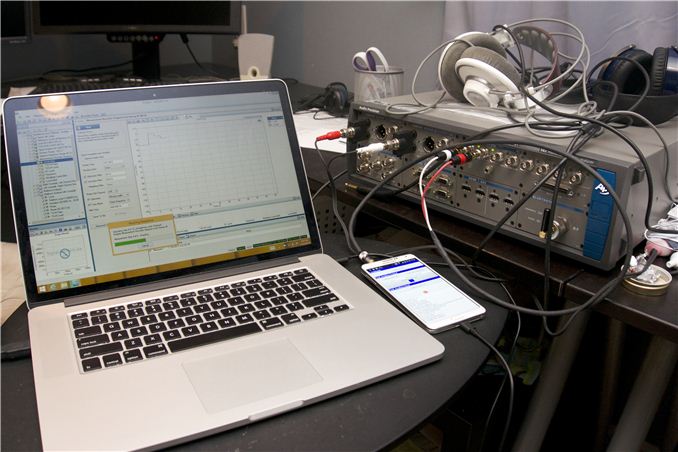Smartphone Audio Quality Testing
by Chris Heinonen on December 8, 2013 5:15 PM EST- Posted in
- Smartphones
- Audio
- Mobile
- Tablets
- Testing

We spend a lot of time watching and listening to our smartphones and tablets. The younger you are the more likely you are to turn to them for watching a movie or TV show instead of an actual TV. For a lot of us it is our primary source of music with our own content or streaming services. Very rarely when new phones or tablets are announced does a company place any emphasis on the quality of the audio.
Display quality also used to receive very little attention. As more and more people reported on the display performance, more companies started to take notice. Now benefits like “Full sRGB gamut” or “dE < 3” are touted on new products. So now we are going to introduce a new set of testing for smart phones and tablets, audio performance.
To do this right we went to the same company that all the manufacturers go to: Audio Precision. Based out of Beaverton, OR, Audio Precision has been producing the best audio test equipment out there for over 25 years now. From two channel analog roots they now also test multichannel analog, HDMI, Optical, Coaxial, and even Bluetooth. Their products offer resolution that no one else can, which is why you will find them in the test and production rooms of almost any company.
Just recently they introduced a brand new set of audio tests for Android devices. Combined with one of their audio analyzers, it allows us to provide performance measurements beyond what has been possible before. Using an Audio Precision APx582 analyzer we set out to analyze a selection of Android phones to see what performance difference we can find. More phones and tablets will follow as these tests can be run.
The Test Platform
The test platform is the Audio Precision APx series of audio analyzers. For this initial set of tests I used an APx 582 model, which has two analog outputs and 8 channels of analog inputs. The outputs are not necessary as all of the test tones are provided by Audio Precision for playback on the devices. For each set of tests we can add a load, simulated or real, to see how the device handles more demanding headphones. For this article I am sticking with only a set of the updated Apple Earbuds. They are probably the most common headphone out there and easy to acquire to duplicate testing. For future tests the other loads will be AKG K701 headphones and Grado SR60 headphones. Both models are popular, and I happen to own them.
There are a few main tests we are going to use for all these reviews. Those key tests are maximum output level, Total Harmonic Distortion + Noise (THD+N), Frequency Response, Dynamic Range (as defined by AES17), and Crosstalk. These tests are the exact same ones that manufacturers will be running to verify their products. Most of these tests will be run at maximum output levels. Most amplifiers perform best at close to their maximum levels, as the residual noise compared to the signal decreases, and so that is what they are typically tested at.
We might add more tests as we decide they are relevant to our testing. I will also attempt to go back and fill in as much data as possible from previously reviewed devices as time permits. Now to look at the tests and see our results for our initial set of phones.










188 Comments
View All Comments
lmcd - Sunday, December 8, 2013 - link
Only Anandtech :-)Curious to see how (badly) the S3 fares.
Old_Fogie_Late_Bloomer - Sunday, December 8, 2013 - link
Even with the occasional stinker of an article (yay, non-removable batteries...?), I have to say......it's stuff like this that keeps me coming back to the site. Only Anandtech, indeed. :) Keep up the quirky, in-depth work.
althaz - Sunday, December 8, 2013 - link
I don't know about the S3, but the S2 was rated very highly for audio quality.quick brown fox - Sunday, December 8, 2013 - link
I believe it was the opposite; S3 was lauded due to its wolfson dac (as well as the original Galaxy S), while S2 was condemned for not using that same DAC.Hopefully all gets measured so we can have some objectivity involved.
MadMan007 - Sunday, December 8, 2013 - link
Yeah but talking about a specific DAC chip is audio nerds looking at just a piece of the equation and using it as a potential red herring. The analog amplifiers and output, and overall implementation, matter much more than which specific DAC chip is used as long as it's not garbage, meaning basically any modern DAC chip.krazyfrog - Monday, December 9, 2013 - link
AnandTech actually tested the audio of the international Galaxy S II in their review and found it to be quite poor.zShowtimez - Monday, December 9, 2013 - link
After just moving from a S2 to a HTC One, let me tell you how awful the S2 was...Samus - Monday, December 9, 2013 - link
The surface(s) all use a wolfson dac and sound fantastic, too. The implementation means nothing if your base source is some realtek crap.Hemlocke - Sunday, December 8, 2013 - link
The i9100 had the Wolfson DAC, but the U.S. Variants didn't.onslaught86 - Sunday, December 8, 2013 - link
The i9100 did not have a Wolfson DAC. The i9300 did, while its US variants did not. And boy was it night & day coming from the i9100.